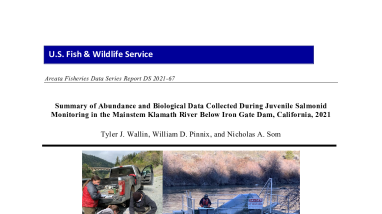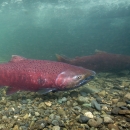This report summarizes results from the 2021 season of juvenile salmonid outmigrant monitoring downstream of Iron Gate Dam on the mainstem Klamath River, California. Trapping occurred at four locations: below the confluence with Bogus Creek (river km 308), just upstream of the Interstate 5 bridge (river km 294), upstream of the confluence with the Scott River near Kinsman Creek (river km 238), and above the confluence with the Trinity River near Weitchpec, California (river km 65). Both frame nets and rotary screw traps were deployed at all sites in early March and operated until late June. Low river flows and high river temperatures prevented the continued operation of traps after June 18. Traps were operated four nights each week from Monday to Friday. All juvenile salmonids in the catch were counted and each day a subset was measured for length, weight, and external symptoms of disease. Non-salmonid fishes were also enumerated and sampled for length measurements. Mark-recapture studies were conducted periodically at the Kinsman and Weitchpec trap sites during the season to estimate trap efficiency. Efficiency estimates and catch data were used to estimate weekly and seasonal outmigration abundance of natural-origin age-0 juvenile Chinook Salmon migrating downstream past the Kinsman trap site using a Bayesian time-stratified population estimation method. Historic data was used to fit a model of discharge and proportion of a week sampled to predict weekly trap efficiencies at the I-5 site. For the periods that traps were operated, season-wide abundance estimates of natural-origin age-0 Chinook Salmon were 926,931 (CI=430,973-1,932,947) at the I-5 trap site, and 782,514 (CI=424,984) at the Kinsman trap site. Efficiency estimates and catch data were used to generate weekly estimates of natural-origin age-0 juvenile Chinook Salmon migrating downstream past the Weitchpec trap site, with an estimate of 1,237,533 (CI=672,202-2,123,426) for the sampling period which did not capture enough of the population to be considered a season-wide abundance estimate. Abundance estimates were not estimated for the Bogus trap site in 2021. The proportion of total juvenile Chinook Salmon that were captured dead was above average in 2021 at all trapping sites, which is consistent with high prevalence of infection by Ceratonova shasta in juvenile Chinook Salmon. Catch of dead juvenile Coho Salmon and steelhead were low and similar to long-term means. Dead fish were not included in abundance estimates.
Publication date
Type of document
Annual Report
Facility
Program
Species
FWS Focus
FWS Focus
FWS Focus
Ecosystem
FWS and DOI Region(s)





